Study on Porosity of Thermal-Sprayed Commercially Pure Aluminum Coating
Abstract
:1. Introduction
2. Experimental Process
2.1. Thermal Spraying
2.2. Sample Preparation
2.3. Sample Characterization
3. Results
3.1. Mechanical Polishing
3.2. Argon-Ion-Beam Polishing
3.3. Electropolishing
4. Discussion
5. Conclusions
- (1)
- Current mechanical polishing and advanced argon-ion-beam polishing are not suitable for revealing the pore structure of a commercially pure aluminum coating, and lead to less porosity statistics.
- (2)
- The electropolishing method can effectively reveal the macropore structure of a commercially pure aluminum coating, but the influence of introduced micropores on its porosity statistics cannot be ignored.
- (3)
- The composite polishing technology (electrolytic polishing + argon-ion-beam polishing) can truly reflect the pore structure of a commercially pure aluminum coating, and the porosity of the coating obtained is 9.9%.
- (4)
- Using the composite polishing technology, electrolytic polishing for 15 s and argon-ion-beam polishing for 35 min (7 kV for 15 min, and then 4 kV for 10 min, with a last step at 1 kV for 10 min) is recommended to reveal the porosity of a commercially pure Al coating.
Author Contributions
Funding
Institutional Review Board Statement
Informed Consent Statement
Data Availability Statement
Conflicts of Interest
References
- Xu, B.S. Thermal spray materials and applications in the 21(st) century. Rare Met. Mater. Eng. 2000, 29, 58–62. [Google Scholar]
- Kumar, S.; Kumar, R. Influence of processing conditions on the properties of thermal sprayed coating: A review. Surf. Eng. 2021, 37, 1339–1372. [Google Scholar] [CrossRef]
- Babu, P.S.; Madhavi, Y.; Krishna, L.R.; Sivakumar, G.; Rao, D.S.; Padmanabham, G. Thermal Spray Coatings for Erosion-Corrosion Resistant Applications. Trans. Indian Inst. Met. 2020, 73, 2141–2159. [Google Scholar] [CrossRef]
- Pawlowski, L. The Science and Engineering of Thermal Spray Coatings, 2nd ed.; John Wiley & Sons Ltd.: Hoboken, NJ, USA, 2008. [Google Scholar]
- Fauchais, P.; Fukumoto, M.; Vardelle, A.; Vardelle, M. Knowledge concerning splat formation: An invited review. J. Therm. Spray Technol. 2004, 13, 337–360. [Google Scholar] [CrossRef]
- Li, C.J.; Ohmori, A. Relationships between the microstructure and properties of thermally sprayed deposits. J. Therm. Spray Technol. 2002, 11, 365–374. [Google Scholar] [CrossRef]
- Yangyang, Z.; Guozheng, M.A.; Haidou, W.; Guolu, L.I.; Shuying, C.; Haijun, W.; Ming, L. Research Status of Pores in Thermally Sprayed Coatings and Their Effects on Coating Performance. Mater. Rev. 2016, 30, 90–96. [Google Scholar]
- Antou, G.; Montavon, G.; Hlawka, F.; Cornet, A.; Coddet, C. Characterizations of the pore-crack network architecture of thermal-sprayed coatings. Mater. Charact. 2004, 53, 361–372. [Google Scholar] [CrossRef]
- Bai, Y.; Zhao, L.; Qu, Y.M.; Fu, Q.Q.; Wang, Y.; Liu, K.; Tang, J.J.; Li, B.Q.; Han, Z.H. Particle in-flight behavior and its influence on the microstructure and properties of supersonic-atmospheric-plasma-sprayed nanostructured thermal barrier coatings. J. Alloys Compd. 2015, 644, 873–882. [Google Scholar] [CrossRef]
- Zhang, X.; Wang, Y.W.; Sun, W.W.; Yang, Y.; Zhang, C.; Ma, Y.D.; Cui, Y.H.; Zhao, C.C.; Wang, L.; Dong, Y.C.; et al. Microstructure and Properties of Al2O3–ZrO2–Y2O3 Composite Coatings Prepared by Plasma Spraying. J. Therm. Spray Technol. 2020, 5, 976–978. [Google Scholar] [CrossRef]
- Thirumalaikumarasamya, D.; Shanmugama, K.; Balasubramanian, V. Influences of atmospheric plasma spraying parameters on the porosity level of alumina coating on AZ31B magnesium alloy using response surface methodology. Prog. Nat. Sci. Mater. Int. 2012, 22, 468–479. [Google Scholar] [CrossRef]
- Qiao, X.; Wang, Y.M.; Weng, W.X.; Liu, B.L.; Li, Q. Influence of pores on mechanical properties of plasma sprayed coatings: Case study of YSZ thermal barrier coatings. Ceram. Int. 2018, 17, 21564–21577. [Google Scholar] [CrossRef]
- Curran, J.A.; Clyne, T.W. Porosity in plasma electrolytic oxide coatings. Acta Mater. 2006, 7, 1985–1993. [Google Scholar] [CrossRef]
- Gao, P.H.; Jia, H.; Wang, W.; Chen, B.Y.; Guo, Y.C.; Yang, Z.; Wang, J.D. Progress of Pore Structure Characterization of Thermally Sprayed Coatings. Rare Met. Mater. Eng. 2019, 48, 3055–3070. [Google Scholar]
- Deshpande, S.; Kulkarni, A.; Sampath, S.; Herman, H. Application of image analysis for characterization of porosity in thermal spray coatings and correlation with small angle neutron scattering. Surf. Coat. Technol. 2004, 187, 6–16. [Google Scholar] [CrossRef]
- ISO/TR 26946; Standard Method for Porosity Measurement of Thermally Spayed Coatings. International Organization for Standardization: Geneva, Switzerland, 2011.
- Sobhanverdi, R.; Akbari, A. Porosity and microstructural features of plasma sprayed Yttria stabilized Zirconia thermal barrier coatings. Ceram. Int. 2015, 41, 14517–14528. [Google Scholar] [CrossRef]
- Ndumia, J.N.; Kang, M.; Lin, J.R.; Liu, J.T.; Li, H. Influence of Heat Treatment on the Microstructure and Wear Properties of Arc-Sprayed FeCrAl/Al Coating. Coatings 2022, 12, 374. [Google Scholar] [CrossRef]
- Esfahani, E.A.; Salimijazi, H.; Golozar, M.A.; Mostaghimi, J.; Pershin, L. Study of Corrosion Behavior of Arc Sprayed Aluminum Coating on Mild Steel. J. Therm. Spray Technol. 2012, 21, 1195–1202. [Google Scholar] [CrossRef]
- Adamiak, M.; Czuprynski, A.; Kopysc, A.; Monica, Z.; Olender, M.; Gwiazda, A. The Properties of Arc-Sprayed Aluminum Coatings on Armor-Grade Steel. Metals 2018, 8, 142. [Google Scholar] [CrossRef]
- Jeong, H.R.; Lee, H.S.; Jalalzai, P.; Kwon, S.J.; Singh, J.K.; Hussain, R.R.; Alyousef, R.; Alabduljabbar, H.; Aslam, F. Sodium Phosphate Post-treatment on Al Coating: Morphological and Corrosion Study. J. Therm. Spray Technol. 2019, 28, 1511–1531. [Google Scholar] [CrossRef]
- Ang, A.S.M.; Berndt, C.C. A review of testing methods for thermal spray coatings. Int. Mater. Rev. 2014, 59, 179–223. [Google Scholar] [CrossRef]
- Kim, J.H.; Lee, M.H. A Study on Cavitation Erosion and Corrosion Behavior of Al-, Zn-, Cu-, and Fe-Based Coatings Prepared by Arc Spraying. J. Therm. Spray Technol. 2010, 19, 1224–1230. [Google Scholar] [CrossRef]
- Nayak, S.K.; Kumar, A.; Sarkar, K.; Banerjee, A.; Laha, T. Corrosion Behavior of Fe-Based Amorphous/Nanocrystalline Composite Coating: Correlating the Influence of Porosity and Amorphicity. Mater. Proc. 2021, 6, 24. [Google Scholar]
- Jiang, R.R.; Li, M.; Yao, Y.R.; Guan, J.M.; Lu, H.M. Application of BIB polishing technology in cross-section preparation of porous, layered and powder materials: A review. Front. Mater. Sci. 2019, 13, 107–125. [Google Scholar] [CrossRef]
- Takahashi, H.; Sato, A.; Takakura, M.; Mori, N.; Boerder, J.; Knoll, W.; Critchell, J. A new method of surface preparation for high spatial resolution EPMA/SEM with an argon ion beam. Microchim. Acta 2006, 155, 295–300. [Google Scholar] [CrossRef]
- Zhan, D.P.; Han, L.H.; Zhang, J.; He, Q.F.; Tian, Z.W.; Tian, Z.Q. Electrochemical micro/nano-machining: Principles and practices. Chem. Soc. Rev. 2017, 46, 1526–1544. [Google Scholar] [CrossRef]
- Deng, H.; Huang, R.; Liu, K.; Zhang, X.Q. Abrasive-free polishing of tungsten alloy using electrochemical etching. Electrochem. Commun. 2017, 82, 80–84. [Google Scholar] [CrossRef]
- Rodriguez, R.; Paredes, R.S.C.; Wido, S.H.; Calixto, A. Comparison of aluminum coatings deposited by flame spray and by electric arc spray. Surf. Coat. Technol. 2007, 202, 172–179. [Google Scholar] [CrossRef]
- He, K.; Zhao, J.H.; Li, P.; He, J.S.; Tang, Q. Investigation on microstructures and properties of arc-sprayed-Al/AZ91D bimetallic material by solid-liquid compound casting. Mater. Des. 2016, 112, 553–564. [Google Scholar] [CrossRef]
- Poznyak, A.; Knörnschild, G.; Karoza, A.; Norek, M.; Pligovka, A. Peculiar Porous Aluminum Oxide Films Produced via Electrochemical Anodizing in Malonic Acid Solution with Arsenazo-I Additive. Materials 2021, 14, 5118. [Google Scholar] [CrossRef]
- Poznyak, A.; Knörnschild, G.; Pligovka, A.; Larin, T. Anodic Alumina Prepared in Aqueous Solutions of Chelating Complex Zinc and Cobalt Compounds. Tech. Phys. 2022, 67, 411–422. [Google Scholar] [CrossRef]
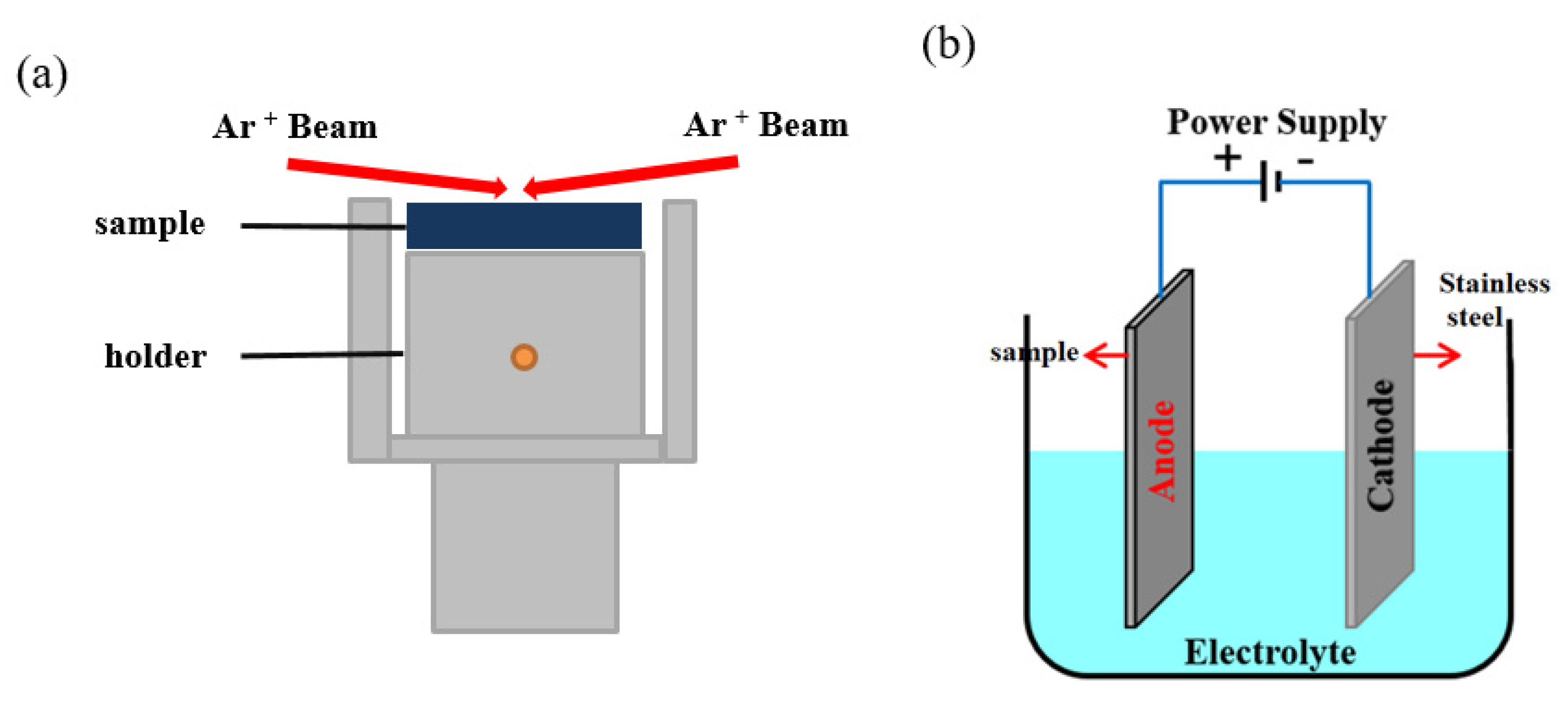
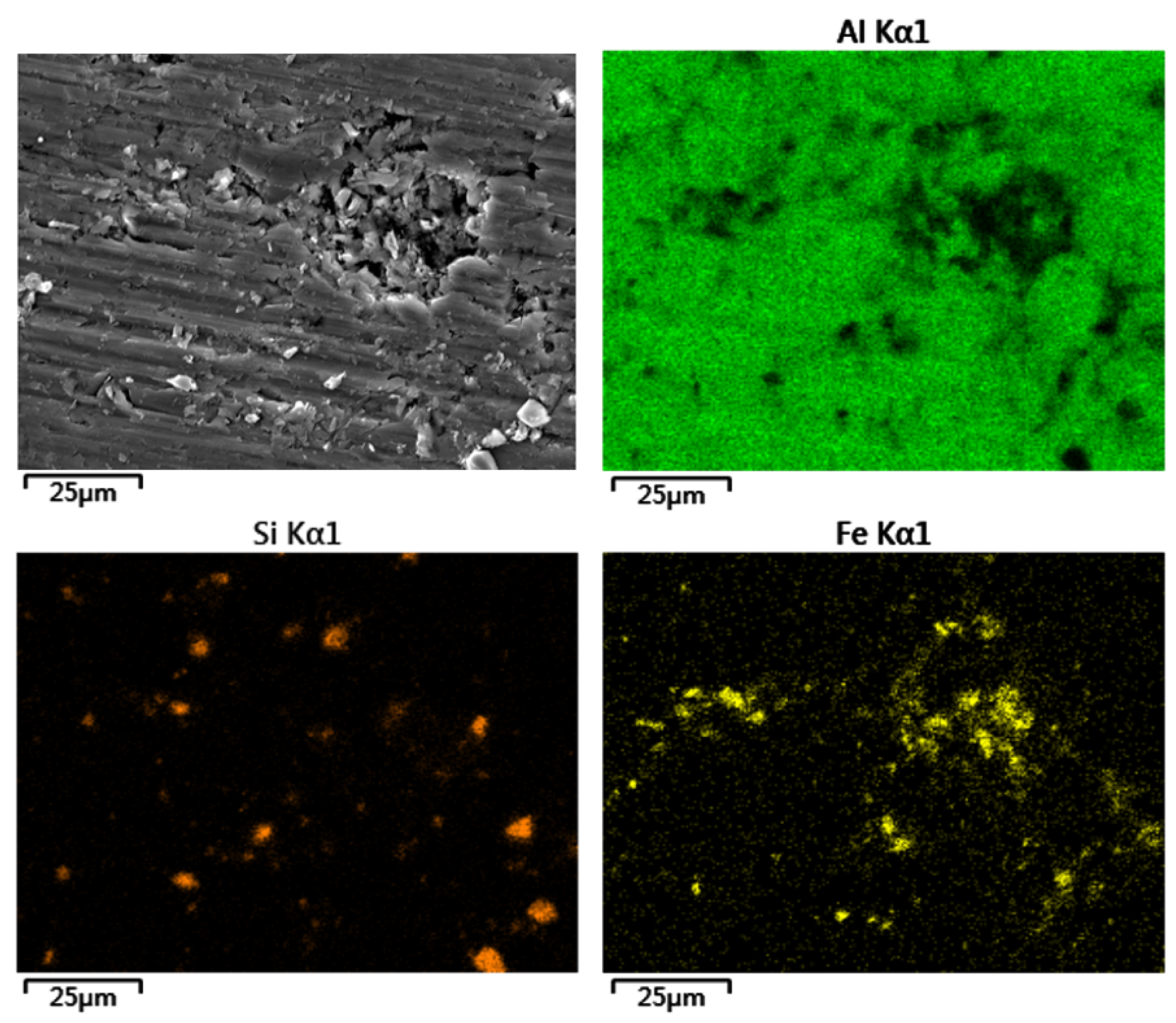

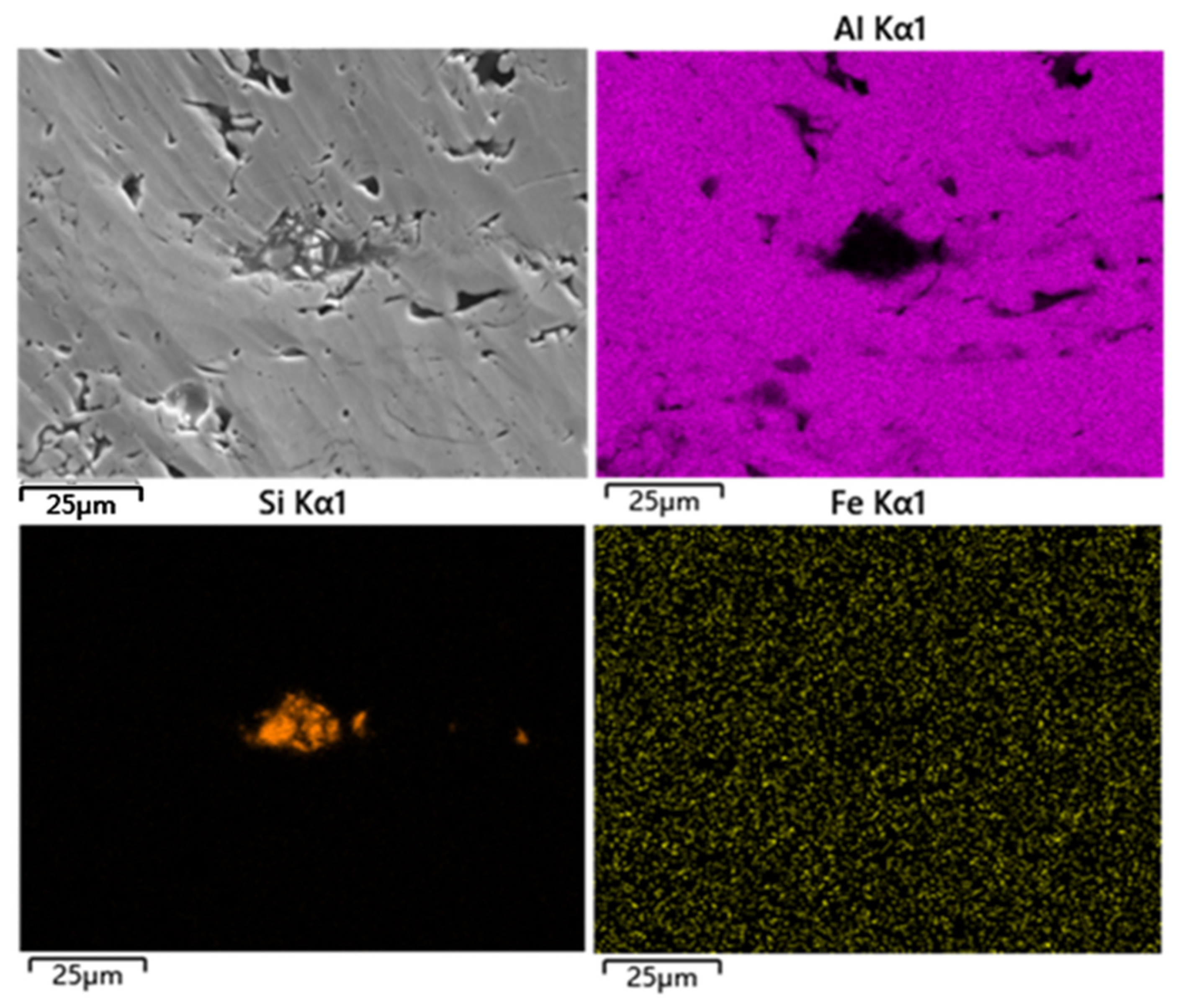
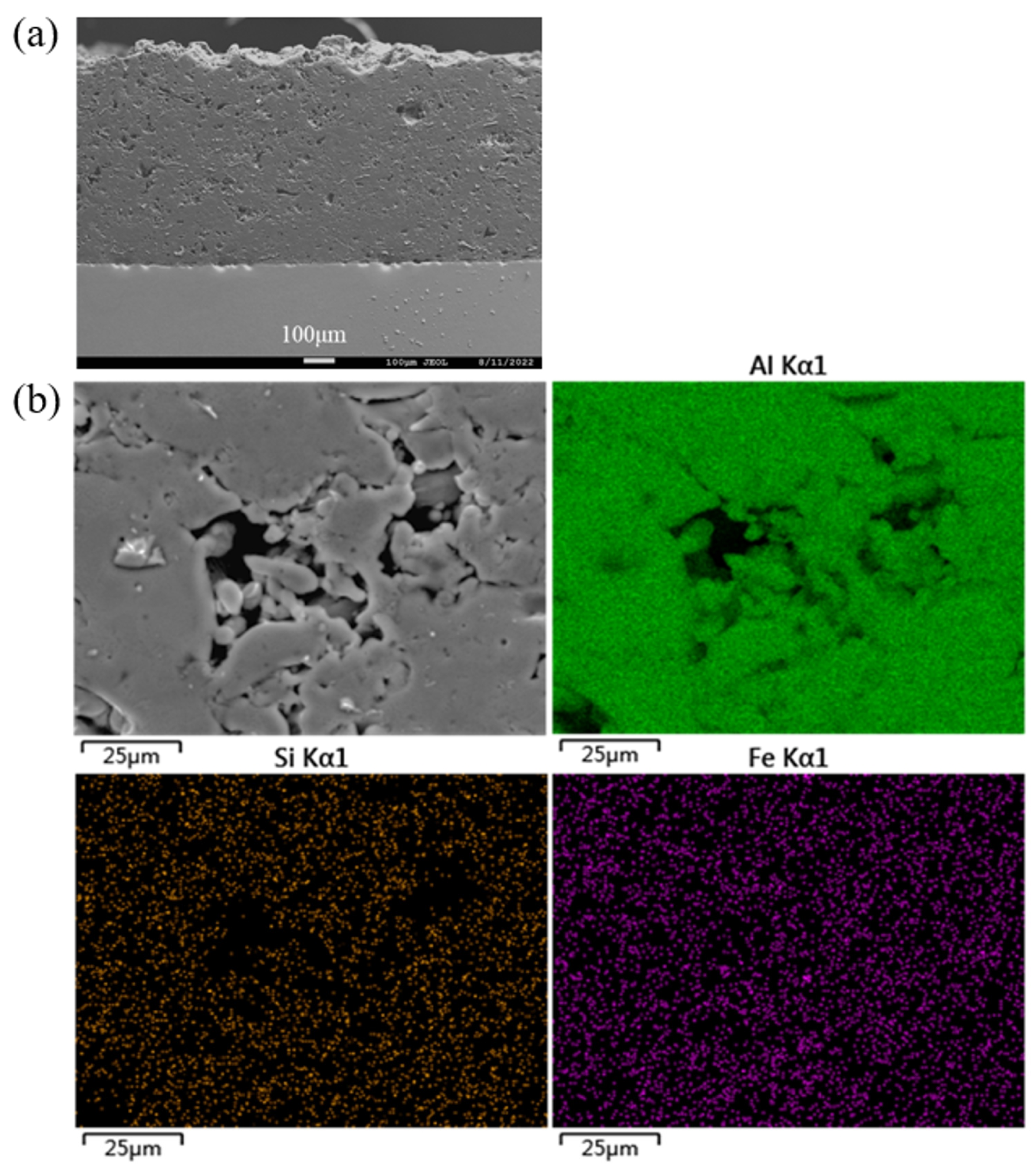
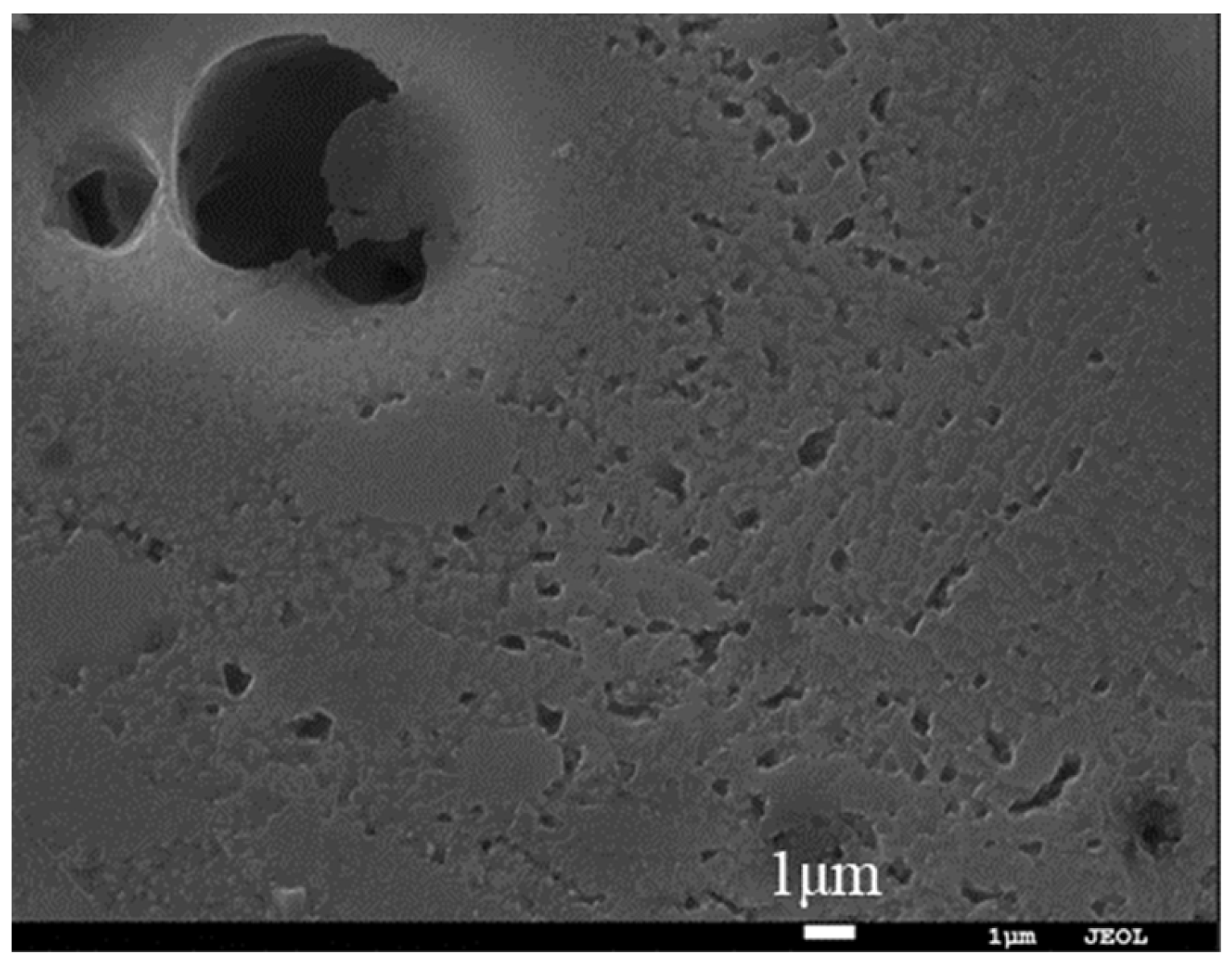
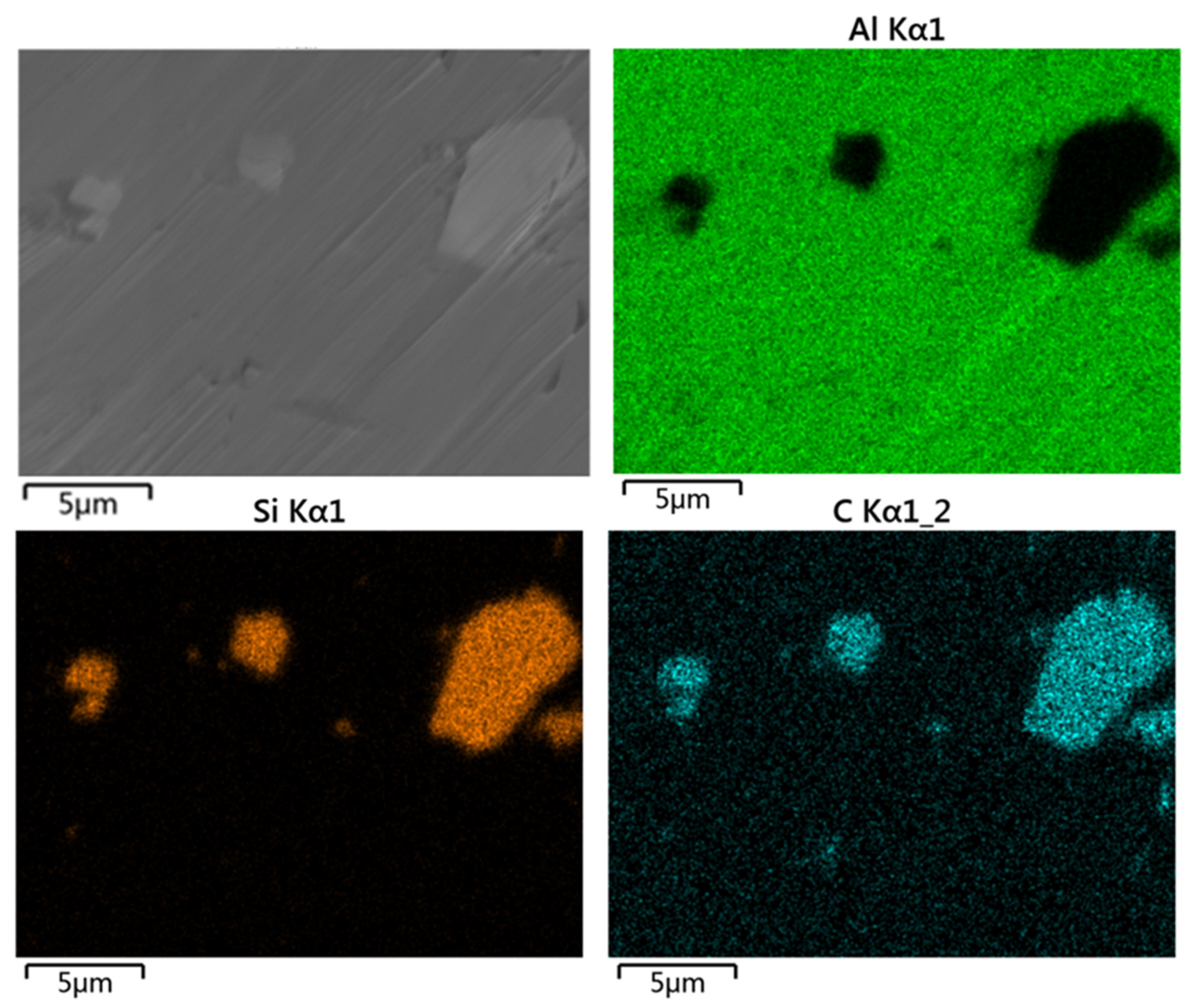
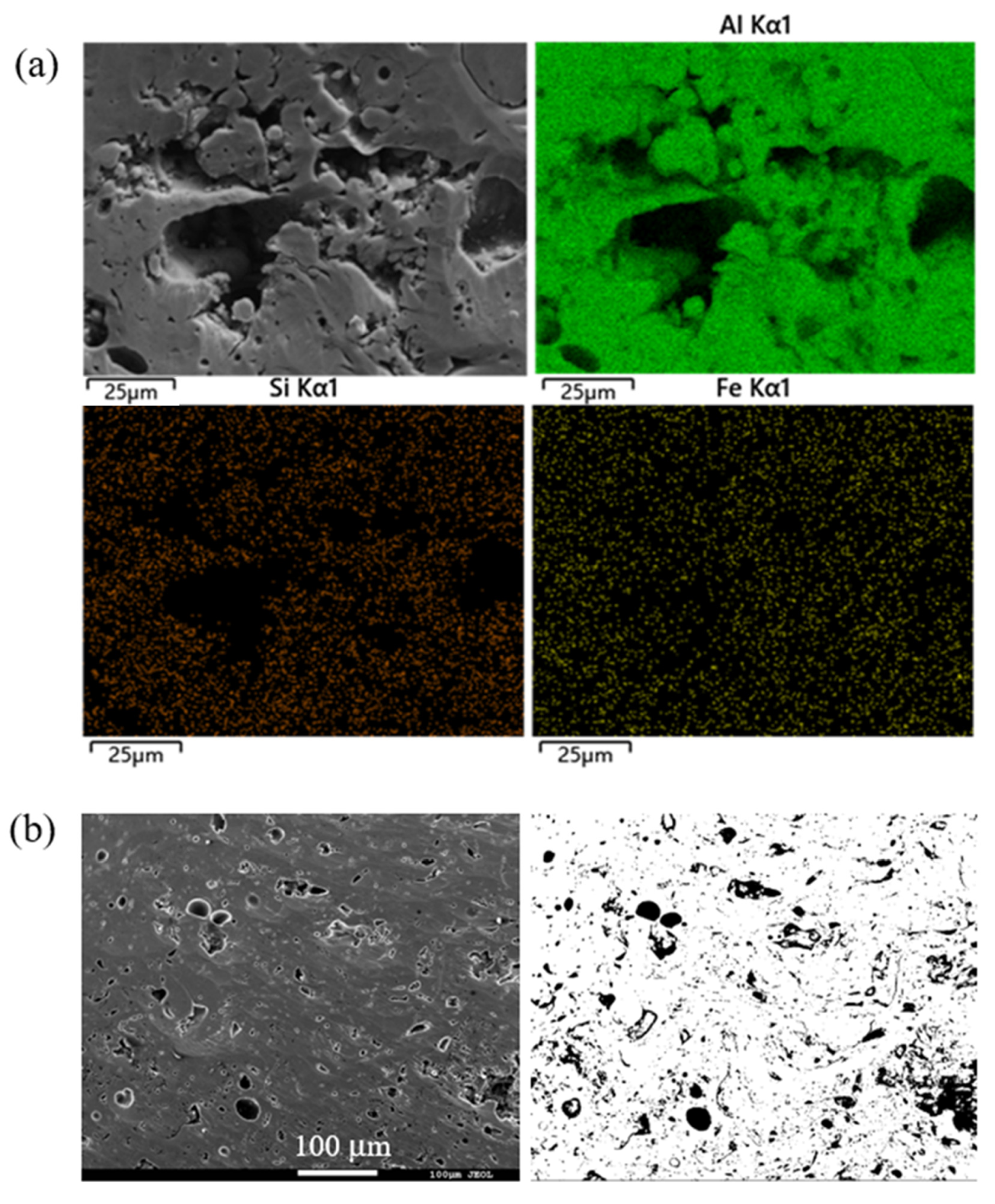
| Mg | Si | Cu | Mn | Zn | Ti | S | P | C | Fe | Al | |
|---|---|---|---|---|---|---|---|---|---|---|---|
| SS400 | - | 0.30 | - | 1.20 | - | - | 0.03 | 0.04 | 0.20 | balance | |
| AA1060 | 0.03 | 0.25 | 0.05 | 0.03 | 0.05 | 0.03 | - | - | - | 0.35 | balance |
| Parameters | Values |
|---|---|
| Voltage, V | 150 |
| Current, A | 30 |
| Distance, mm | 180 |
| Speed, m/s | 0.05 |
| Coating thickness, μm | 600–700 |
| Polish Method | Mechanical Polishing | Argon-Ion-Beam Polishing | Electrolytic Polishing | Combination Polishing |
|---|---|---|---|---|
| Porosity (%) | <0.5 ± 0.3 | <5.0 ± 0.8 | ~8.6 ± 1.8 | ~9.9 ± 0.8 |
| Pore Character | Shape | Size (μm) | Number | Distribution |
|---|---|---|---|---|
| Interconnected pore | Irregular | 25–100 | 6 | Inhomogeneous |
| Isolated pore | Round or irregular | 2–20 | 41 | Inhomogeneous |
| Interlayer pore | Curved | 10–100 (in length) | 18 | Inhomogeneous |
| Micro pore | Round | <1 | 286 | Uniform |
Disclaimer/Publisher’s Note: The statements, opinions and data contained in all publications are solely those of the individual author(s) and contributor(s) and not of MDPI and/or the editor(s). MDPI and/or the editor(s) disclaim responsibility for any injury to people or property resulting from any ideas, methods, instructions or products referred to in the content. |
© 2023 by the authors. Licensee MDPI, Basel, Switzerland. This article is an open access article distributed under the terms and conditions of the Creative Commons Attribution (CC BY) license (https://creativecommons.org/licenses/by/4.0/).
Share and Cite
Li, B.; Fan, L.; Bai, J.; He, J.; Su, J.; Wang, S.; Deng, C.; Liu, S.; Zhang, Z. Study on Porosity of Thermal-Sprayed Commercially Pure Aluminum Coating. Materials 2023, 16, 6612. https://doi.org/10.3390/ma16196612
Li B, Fan L, Bai J, He J, Su J, Wang S, Deng C, Liu S, Zhang Z. Study on Porosity of Thermal-Sprayed Commercially Pure Aluminum Coating. Materials. 2023; 16(19):6612. https://doi.org/10.3390/ma16196612
Chicago/Turabian StyleLi, Bo, Lei Fan, Jie Bai, Jinhang He, Jianfeng Su, Song Wang, Chao Deng, Shifeng Liu, and Zhiqing Zhang. 2023. "Study on Porosity of Thermal-Sprayed Commercially Pure Aluminum Coating" Materials 16, no. 19: 6612. https://doi.org/10.3390/ma16196612
APA StyleLi, B., Fan, L., Bai, J., He, J., Su, J., Wang, S., Deng, C., Liu, S., & Zhang, Z. (2023). Study on Porosity of Thermal-Sprayed Commercially Pure Aluminum Coating. Materials, 16(19), 6612. https://doi.org/10.3390/ma16196612









